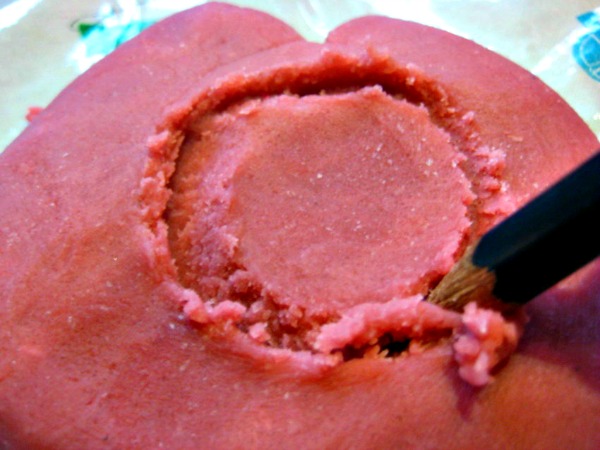
We’ve been mixing two of our favourite things this week: playdough and art. My girls love to make and create, especially if they can make something to play with too. Here’s their winter woodland with a forest of Christmas trees. [Read more…]
Outer Space Playdough
Play dough recipe
Need a play dough recipe? Salt dough recipe, bread dough recipe, no cook play dough recipe?
How about a year’s worth of playdough play ideas – including math, literacy and creative play.
Now available: an all-new-and-improved Homemade Play Dough Recipe Book!
come and take a look!
Mark making with play dough
Help your child learn pre-writing skills through mark making with play dough.

Mark making with play dough
We are huge fans of play dough in our house. We’ve just made a new batch using our favourite play dough recipe with some orange essence added to bring some smelly sensory fun.
I find play dough is a great activity for after school, especially if we have a mixed age group of children playing. It’s very relaxing as it has the lovely touchy-feely aspect of sensory play and there’s no right or wrong way to play with it – so however old you are (grandparents included!) you can enjoy it, without finding it frustrating or needing any grown-up interference.

Today I thought I’d mention how fabulous play dough is on the road to learning to write. While you might not associate dough with holding a pencil, all the kneading and shaping you do as you play is just right for building up fine motor skills – giving little fingers lots of practise in mobility, grasping and manipulating.
If your child is showing an interest it’s easy to extend the play by providing something to ‘write’ with, whether it’s a blunt pencil, stick, feather or other tool. By sitting alongside your child as they play you can model mark making, gently suggesting different patterns to try and seeing if they’d like to copy.
Try using a variety of marks which correspond to the shapes included when you eventually begin to write letter characters: horizontal and vertical lines, zigzags, circles, waves and loops.
You might find that children who are otherwise reluctant to ‘write’ do enjoy this kind of mark making. It’s a good option to introduce early writing skills to children who show little interest in pencils and paper.
10 playdough ideas
Welcome to the first @nurturestore #goplay Twitter Tips. Tonight: 10 ideas to get the most fun from play dough
#goplay Tip #1: playdough is perfect when you have a mixed age group playing together: everyone can play their way
#goplay Tip #2: play dough is a good introduction to messy play for children (and parents!) who don’t like mess
#goplay Tip #3: use this recipe to make your own play dough: food ingredients so OK is the kids eat a sneaky bit
#goplay Tip #4: play dough is so good for encouraging creativity, you could make this 
#goplay Tip #5: bring an extra sensory experience to play dough by adding food essences or essential oils: vanilla, peppermint, orange
#goplay Tip #6: manipulating play dough is perfect for fine motor skills – getting fingers ready for holding a pencil one day
#goplay Tip #7: a pot of homemade play dough is perfect for party loot bags. Try this recipe
#goplay Tip #8: try adding in different resources each time you use play dough and see how your kids play creatively
#goplay Tip #9: other things to add to play dough play: lollysticks, matchsticks, shells, cookie cutters, knives & forks, feathers…
#goplay Tip #10: try using play dough in a different place: the garden, the toy kitchen, the dolls’ house. Give kids a fresh challenge
>>>Download our free Playdough recipe and ideas ebook >>>
Teach the alphabet with dough

A simple bread dough is a perfect medium for children to explore with. It’s easy to make using ingredients you can keep in your storecupboard and I find children always take great pleasure in using ‘real grown-up’ materials. There are lots of ways you can use a bread dough to let your children play with counting, measuring, pouring, cutting. Today we’ve been teaching the alphabet with bread. We’ve a recipe and a song to share with you.
Weigh 500g of strong bread flour and a teaspoon of salt out into a big bowl. Little thought it felt very tickly.
Pour in 300ml of warm water and a tablespoon of olive oil using good hand-eye co-ordination. Little liked mixing the colours to combine all the ingredients into a ball of dough.
Develop strength in your fingers by kneading the dough for 5 minutes on a floured surface. (Getting fingers ready to one day hold a pencil and write well.)
Introduce some letters by making your own dough alphabet. (If you want to use the recipe to make a proper loaf you can shape it and then leave it to prove for 45 minutes before baking.)














